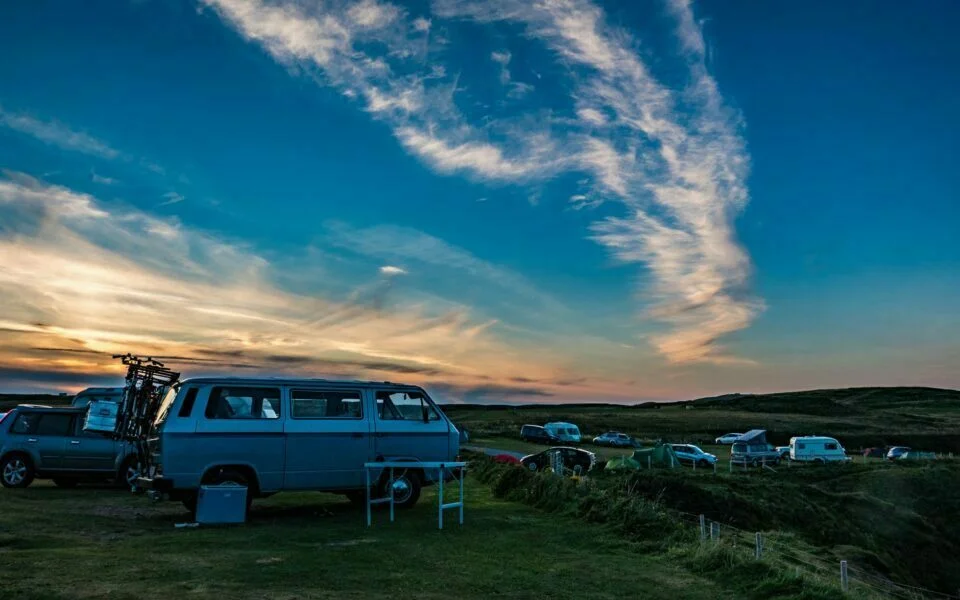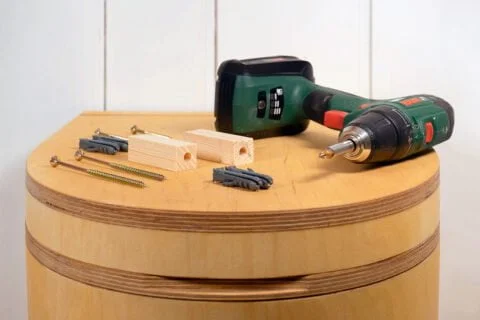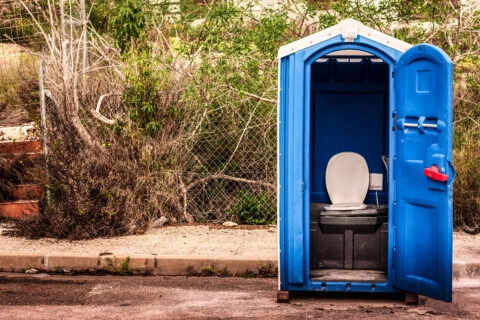TROBOLO BilaBox
Practical and ultra-light, mobile composting toilet in a compact Eurobox format.

Van Life: From trend to lifestyle. More and more people choose to go into nature.
The attractiveness of van life – whether long-term or even just for holidays or weekend trips – is obvious to many of its fans. Instead of having to plan months in advance, as is the case with other trips, you can get right in, drive off and leave the grey daily routine behind you immediately.
Travelling with children also gives them valuable experiences in nature, which they often have less and less opportunity to do these days. And travelling with four-legged friends is also much easier to do with van life than with more traditional holidays. Furthermore, travelling in a van is considered to be particularly sustainable and has many supporters, not least because of this. However, very few people are aware that if done incorrectly, you can actually cause unintentional harm to the environment. Below we have therefore compiled the most important dos and don’ts on the subject of sustainability and van life.
Aside from the hard-to-avoid CO2 emissions caused by fuel consumption, a holiday or even a long-term stay at a campsite or van life goes along extremely well with a sustainable lifestyle – and is also far more environmentally friendly than long-haul flights or even a package tour on a cruise ship! The following fact-check will show you exactly how this works.

Minimalism: Even if you don’t aim for maximum sustainability in your van – living in a van almost forces you to adopt a sustainable lifestyle, because space constraints mean you have to limit yourself to the essentials and, compared to an 80m² apartment, you already save a lot of resources without really having to take action in terms of sustainability.
Consumer behaviour: The manageable size of the living space in a van also means that you inevitably have to adapt your consumer behaviour. In contrast to conventional ways of living, there is no danger of falling into the usual consumer behaviour, which regularly tempts us to embellish our beloved home here and there with a new armchair or the latest Ikea lamp. The calculation is simple: what is not bought does not have to be re-produced and thus saves resources.
Water and energy consumption: Similar to the question of space, the same applies here: What is only available in limited quantities is used more consciously and above all more economically. In a normal household you have permanent and unlimited access to water. In a van the opposite is true, which automatically leads you to use less water. The same applies to heating. If you are travelling in a van in winter, you may need an independent heater. But: the energy for this can be generated by a second battery, which is charged by the van’s alternator during the journey, or by solar panels.

Waste reduction: vrom low-waste to zero-waste – van life or even life on a parking lot makes it quite easy to avoid waste as much as possible compared to a conventional life in an apartment or house. For example, food in a compact van refrigerator is not in danger of being forgotten in some hidden corner, as is often the case, whereupon it usually ends up in the trash can. Those who want to improve their waste balance even more, after all, simply do without the known culprits. That means: plastic in all kinds and forms. Use cloth bags instead of plastic bags, exchange the to-go cup for your own (you always have it with you in the van anyway), do without straws, etc. Furthermore, many plastic products can be replaced by natural alternatives. The conventional plastic toothbrush, for example, with one made of bamboo, which is biodegradable and, unlike its plastic counterpart, does not sit around for hundreds of years or turn into microplastic. DIY enthusiasts can also make their own cosmetics and care products and thus firstly have control over the ingredients used, and secondly can reduce further packaging waste.
Nature conservation rules: Rules of nature conservation or rules of conduct serve to protect the local flora and fauna and should always be followed. Even if some of them may seem exaggerated, a local expert has always thought about them and has drawn up the rules mainly as a result of (nature-damaging) precedents. A campfire in the wrong place does not necessarily lead directly to a forest fire, but can be disturbing to native animals in sensitive phases, such as breeding periods. The same applies to dogs running free. So if you are serious about sustainability, in these cases you should accept a slight restriction on the newly won freedom of your van life and take into account all applicable nature conservation rules.
Toilet choice: If you generally choose not to have an on-board toilet in your own van, you will reduce your consumption of resources, as many models require water and electricity. At the same time, however, you also lose a large portion of comfort, which becomes unpleasantly noticeable at night, in case of illness or bad weather. If you are forced to leave the van under such circumstances, it can be very unpleasant. Thus, choosing not to have a toilet in your the van is not necessarily recommendable, even if there might be one or two hardened vanlifers who have come to terms with the absence of a toilet. In the following we will therefore do a detailed fact-check on which toilet variants are suitable for van life and how they perform in terms of sustainability.
In principle, there are two toilet variants that can be used as an on-board toilet in a van or motor home: chemical toilets and dry toilets.
Chemical toilets in their most basic form are quite inexpensive to purchase and are still installed as standard in many motorhomes. However, this circumstance should not inspire false confidence in the customer!
Although chemical toilets do their job relatively reliably, in that they stop the decomposition of urine and faeces and thus prevent odour formation to a certain extent, all this happens at a high price, which our environment ultimately pays. Because of the chemical substances used, these toilets must not be emptied in nature under any circumstances, but only at specially equipped disposal facilities. However, even if the contents of your chemical toilet are disposed of correctly, they still have to be defused” or reconditioned at great expense. Chemical toilets may seem practical at first glance, but due to the chemical substances used, they are real sustainability killers and therefore not recommended.

Composting toilets have the great advantage that they do not require any water supply at all, and in some cases even no electricity, which places them high up on the sustainability scale. In addition, contrary to some persistent clichés, they reliably prevent the formation of odours and are only dependent on the use of litter, which is added to the waste, or the removal of air. Disposing of the contents of a dry toilet is also easy to reconcile with a sustainable lifestyle: urine collected separately can be diluted with water and used as fertiliser or disposed of in a permanent toilet. If you are travelling with a van, of course you don’t have a flower bed with you that would benefit from this fertiliser. But the message is clear: urine mixed with water can be used for the good of nature. Although the solid waste container requires a collection bag, this does not have to be made of plastic – it is also available in a biodegradable version. Thus, the use of a dry toilet allows you to deal with your leftovers in the most sustainable way.
In direct comparison with other toilet variants for vans and motor homes, dry toilets therefore make a significantly higher contribution to sustainability than chemical toilets. Due to the chemicals used, the latter are also anything but sustainable and a direct burden on nature.
Finally, when it comes to sustainability, it is always important to remember that sustainability does not begin with the use of a sustainable product (here: a dry toilet), but rather with its production. TROBOLO dry toilets meet all the criteria for sustainable use of resources. At TROBOLO we are firmly committed to sustainable business and have made this our company philosophy. The wood for our composting toilets comes from sustainable forestry. We treat all our employees and suppliers fairly and are guided by the highest level of quality awareness in every step of work and production.
This credo ultimately enables us to offer our customers a long-lasting, sustainably and fairly produced quality product – not only for indoor and outdoor use, but now also for your van, motorhome or Tiny House.
Sign up for our newsletter here to never miss out on any news or free promotions.

"Do-it-yourself" is the latest trend, so it's not surprising that more and more people want to build their composting toilet themselves. But how does that actually work? In this article, we take a closer look at the topic and give you numerous tips and tricks to make your do-it-yourself project a success. Have fun!
Read more
Below you will find information on functionality, areas of application as well as advantages and disadvantages of dry toilets.
Read more
In this guide, you will find information about the functionality, areas of application as well as the benefits and disadvantages of chemical toilets.
Read more¡Tenemos buenas noticias! Aunque gran parte de nuestro contenido todavía esté en inglés, ya hacemos envíos a tu país. Solo tienes que hacer el pedido y los productos te llegarán directamente a casa.
De acuerdoBuone notizie! Anche se la maggior parte dei nostri contenuti è ancora in inglese, spediamo già nel tuo paese. Fai un ordine e ricevi i prodotti direttamente a casa tua.
D'accordoVi har gode nyheder! Selvom det meste af vores indhold stadig er på engelsk, sender vi nu til dit land. Du skal bare afgive din ordre, så bliver produkterne leveret direkte hjem til dig.
ForståetWe hebben goed nieuws! Hoewel het meeste van onze inhoud nog steeds in het Engels is, verzenden we nu naar uw land. Plaats uw bestelling en de producten worden direct bij u thuisbezorgd.
BegrepenYou are currently viewing a placeholder content from Facebook. To access the actual content, click the button below. Please note that doing so will share data with third-party providers.
More Information